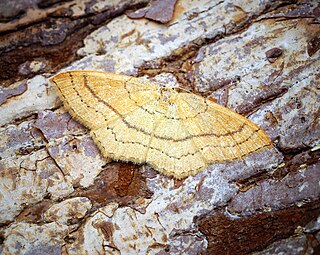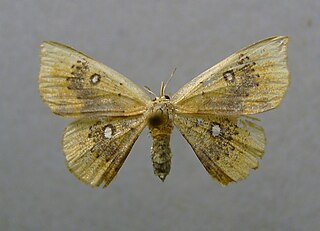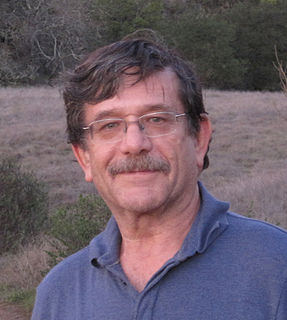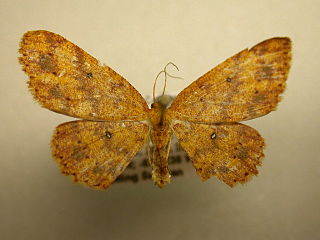In statistics, the false discovery rate (FDR) is a method of conceptualizing the rate of type I errors in null hypothesis testing when conducting multiple comparisons. FDR-controlling procedures are designed to control the FDR, which is the expected proportion of "discoveries" that are false. Equivalently, the FDR is the expected ratio of the number of false positive classifications to the total number of positive classifications. The total number of rejections of the null include both the number of false positives (FP) and true positives (TP). Simply put, FDR = FP /. FDR-controlling procedures provide less stringent control of Type I errors compared to familywise error rate (FWER) controlling procedures, which control the probability of at least one Type I error. Thus, FDR-controlling procedures have greater power, at the cost of increased numbers of Type I errors.

Entomocorus is a genus of catfishes of the family Auchenipteridae.

Cyclophora albipunctata, the birch mocha, is a moth of the family Geometridae. The species was first described by Johann Siegfried Hufnagel in 1767. It is found in the Palearctic. The southern boundary runs westward along the French Atlantic coast and to the British Isles and north of the Alps. In the east, the species ranges to the Pacific Ocean. South of the northern Alps line, it is found at some high elevation areas and mountains. In the Pyrenees, the Massif Central, the southern Alps, the northern Dinaric Alps, in the western and northern Carpathians, in northern Turkey and the Caucasus. In the north, the range extends up to the Arctic Circle. In the Far East the nominate subspecies is replaced by Cyclophora albipunctata griseolataStaudinger, 1897.

Cyclophora porata, the false mocha, is a moth of the family Geometridae. The species can be found in southern Europe and England to Denmark, southern Sweden and the Caucasus.

Cyclophora punctaria, the maiden's blush, is a moth of the family Geometridae. The species was first described by Carl Linnaeus in his 1758 10th edition of Systema Naturae. The species is mainly prevalent in Central and Eastern Europe. In the north, its distribution extends to southern Fennoscandia and the British Isles, in the west via France to parts of northern Spain, in the south via Italy, the Balkan Peninsula to Asia Minor. The eastern border of the distribution is roughly the Ural. In the Caucasus area, the nominate subspecies is replaced by the subspecies C. punctaria fritzae. The range of this subspecies extends as far as Iran.Cyclophora punctaria is found mainly in wooded areas with oak scrub and oak forests. In Central Europe it rises up to 700 metres in the hills, rarely up to 1,200 metres in the Alps, and regularly rises to 1,300 metres in southern Europe.

Cyclophora puppillaria, or Blair's mocha, is a moth of the family Geometridae. The species was first described by Jacob Hübner in 1799. It can be found in Europe and from North Africa up to the Caucasus area.

Cyclophora linearia, the clay triple-lines, is a moth of the family Geometridae. The species was first described by Jacob Hübner in 1799 and it can be found in Europe and Britain.

Cyclophora ruficiliaria, the Jersey mocha, is a moth of the family Geometridae. The species was first described by Gottlieb August Wilhelm Herrich-Schäffer in 1855. It can be found in Europe, in particular the Channel Islands as well as other parts of the mainland United Kingdom.

Cyclophora is a genus of moths in the family Geometridae. Many species are referred to as mochas in reference to their colouration, primarily in Europe.

Catocala benjamini, or Benjamin's underwing, is a moth of the family Erebidae. The species was first described by Auburn Edmund Brower in 1937. It is found in the US states of Arizona, Nevada, southern California and southern Utah.

Lasionycta benjamini is a moth of the family Noctuidae. It is found in the Sierra Nevada of California and in the mountains of Nevada and Colorado.

Cyclophora nanaria, the dwarf tawny wave, is a moth of the family Geometridae. The species was first described by Francis Walker in 1861. It is found in the US from California to Texas and from New Jersey to Florida west along the Gulf Coast. The range extends south through Dominica and Jamaica to Argentina. It is an introduced species in Hawaii.

Cyclophora obstataria is a moth of the family Geometridae first described by Francis Walker in 1861. It is known from the Indian subregion, Sri Lanka and China to Sundaland, New Guinea and Queensland in Australia.

Cyclophora albiocellaria is a moth of the family Geometridae. It is found in south-eastern Europe and parts of Central-Asia.
Keyseria is an extinct genus of dicynodont therapsid. The type species K. benjamini was first named in 1948 as Dicynodon benjamini.

Yoav Benjamini is an Israeli statistician best known for development of the “false discovery rate” criterion. He is currently The Nathan and Lily Silver Professor of Applied Statistics at Tel Aviv University.

Cyclophora aurantiata is a moth in the family Geometridae. It is found in Peru and Costa Rica.
Estola benjamini is a species of beetle in the family Cerambycidae. It was described by Stephan von Breuning in 1940. It is known from Colombia.
Itai Benjamini is an Israeli mathematician who holds the Renee and Jay Weiss Chair in the Department of Mathematics at the Weizmann Institute of Science.
Tornos benjamini is a species of geometrid moth in the family Geometridae. It is found in Central America and North America.













